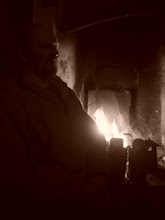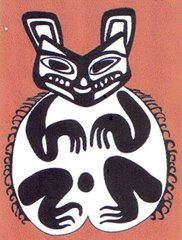Now the old saying goes that there is more than one way to skin a cat and this is true and its not just cats we can skin! In a long term survival or emergency situation our aim would be to utilize every part of the animal but were game is plenty or where we have other uses in mind for instance the construction of decoys skinning is a valid option and should not be ruled out. Birds can be skinned just a readily as mammals and such a method as described below is far less pain stacking and messy then spending time laboriously plucking.
So how do we begin?
Firstly take one bird, any size.

Using finger and thumb carefully pluck bare a small area of flesh at the point where the stomach joins the breast bone.
Then using our knife gently slice the skin open – one cut should suffice here as we don’t want to go deep and damage the stomach wall as our aim it not to damage the meat or internal organs and rupturing the stomach could release bodily fluids which would taint the meat.
Inserting you fingers slowly pry open the flesh until you have made a hole roughly big enough for you to get your fingers in. Place you knife to one side (during butchery and game prep is the only time we do not return our knife directly back into the sheath).

Now manually enlarge the hole to expose the stomach lining and bottom of the breast or chest cavity.
This done, take you knife and again carefully nick the stomach lining to make it easier for you to pull open as before still exerting maximum care through out not to damage any organs needlessly.
Now you can reach inside and remove all the internally organs, you will also need to reach up into the chest and remove heart, lungs also.

Internal organs are of use to us so do not automatically discard. A study of these will reveal feeding signs for instance or we can use them as bait for traps and of course remember you can still eat most parts of these (the offal) too in soups or stews for instance. Try to waste nothing, this not only shows the highest respect for the creature but also the highest standard of woodcraft possible too.
Identify and check the condition of the liver, abnormalities should always be treated with caution and if unsure as to whether the liver is healthy or not always err on the side of caution and discard the whole animal or bird rather than risk the potential of ingesting some disease or illness.
Now, with our game cleaned internally, we move onto the actual act of skinning. You will notice that until now the skin has remained on - this is designed to protect the meat from dirt and damage as the internal organs were removed and is a pertinent technique with both mammals and birds.
So to the skinning, firstly remove the head (if stewing the bird leave as much neck on as possible), wings at the elbow and legs at the knees (read appropriate words for mammals)
Now slice or tear (depending on planned usage of skin) the skin from the opening we’ve created to the throat.
Essentially removing the skin is like removing a jacket. But bear in mind some skins are harder to remove than others, badgers and squirrels are really hard. For a deer you need to use a fist to push and pull the flesh away from the meat. Starting where most comfortable peel off the skin entirely from top to bottom until it has been removed entirely and your bird looks like the below.
Ideally at this stage we should wash the bird with clean water – if using a water bottle avoid contaminating the bottle with dirty hands or by touching its mouth to any exposed meat or bodily fluids.
The jointing and butchering is now down to you or you can opt to roast or boil whole remembering most goodness will be saves if boiled and made into a stew.

I’d suggest you use your knife as little as possible. Follow the visible white(ish) lines which denote where muscle and bone meet. Try to cut with surgical precision to avoid waste or unwanted damage.
The killing of an animal shouldn’t be an action taken lightly and the greatest of respect should always be paid to the dead creature with this in mind always prepare you game cleanly and professionally. Native peoples would pray to the spirit of the game and thank it for giving itself to them and for having the wisdom to surrender it’s live so that the hunter could live and this is something we should also do. Burial of any food scraps and waste is also a way of showing respect and will also ensure we do not invite vermin or disease into our camp.
I hope you have found this interesting, the basic technique above will work on most creatures however please use common sense if you come to practice this skill as I have deliberately not covered every aspect due to the fact the minor changes of technique are two numerous to mention here.Final thought, always practice safety and cover any open cuts on your hands before butchery.
Always clean your knife thoroughly before returning it to its sheath. Never risk cross contamination






















No comments:
Post a Comment